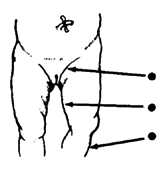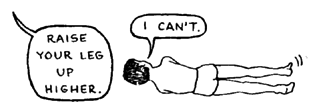Disabled Village Children
A guide for community health workers,
rehabilitation workers, and families
PART 1
WORKING WITH THE CHILD AND FAMILY:
Information on different Disabilities
B. Recognizing, Helping with, and Preventing Common Disabilities
CHAPTER 18
Hip Problems
DISLOCATED HIPS
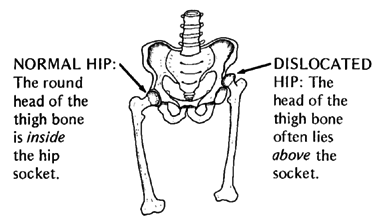
A hip is dislocated when the thigh bone is out of its socket at the hip. Some babies are born with one or both hips already dislocated. Sometimes these babies have no other problem. With early treatment, the problem can often be corrected easily, and the child will not be disabled or have a limp.
For this reason it is important to examine all babies when they are 10 days old to see whether they have dislocated hips.
|
1. Compare the 2 legs. If one hip is dislocated, that side may show these signs:
|
|
2. Hold both legs with the knees bent, like this, 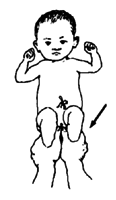
|
|
and open them wide, like this. 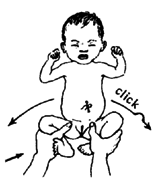
If one leg stops early or makes a jump or click when you open it wide, the hip is dislocated. |
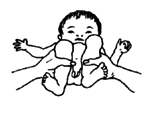
3. To test a slightly older child, bend the knees and compare their height. If one knee is lower, the hip on that side is probably dislocated. |
Treatment
Keep the baby with his knees high and wide apart. To do this,
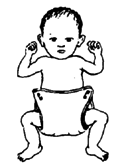
-
use many thicknesses of diapers (nappies) like this,

- or pin his legs like this (when the baby sleeps),
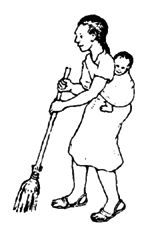
- or carry the baby like this.
In places where babies are traditionally carried with their legs spread on the woman's hips or back, usually no other treatment is necessary.
Dislocated hips with other orthopedic problems
![]()
Children with the disabilities listed here often are born with dislocated hips. Therefore, it is essential to examine these children carefully a few days after birth, to make sure there are no dislocations.
- Down syndrome
- spina bifida
- arthrogryposis
- cerebral palsy
- club feet
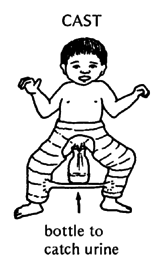
Many (but not all) dislocated hips can be corrected in the ways we described on page 155. Keeping the legs wide apart during the first months of the child's life helps to improve the shape of the socket.
If it is difficult to keep the legs apart, you may need to use casts or make special braces.
The casts should be used for 2 to 4 months or longer, depending on the child's age (longer for older children) and the amount of the deformity. (Use a cloth or bottle to catch the baby's pee, so it does not run inside the cast.)
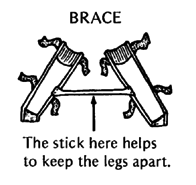
Not all dislocations can be corrected in these ways. Some need surgery, and in some cases the hip is so deformed that the dislocation cannot be corrected, even with surgery.
With spina bifida, if one hip is dislocated, surgery may help. But if both hips are dislocated, hip surgery usually will not help the child to walk any better. (See Page 173.)
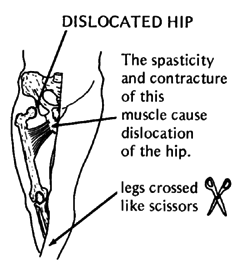
![]()
Dislocated hips can also occur after the child is born, either from an accident or as a complication of some other disability- especially polio (due to weakness in the muscles and cords that hold the hip joint together) or cerebral palsy (due tospasticityandcontractures).
THE TELESCOPE TEST
To find out if the hip is dislocated or can easily be pulled out of joint, place the child on his back.
Pull up on his knee, and then push it down, like this.
At the same time, feel his hip with your other hand, like this.
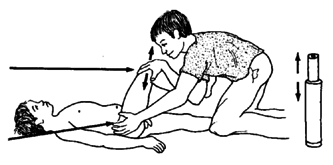
If the thigh bone moves in and out like a telescope, the hip is probably dislocated.
Dislocations that are complications of polio or cerebral palsy can seldom be corrected without surgery. But often it is better not to operate, because the operations do not always turn out well, and the children who have the possibility of walking will walk in spite of the dislocated hips.
HIP PROBLEMS DUE TO DESTRUCTION OR SLIPPING OF THE CAP OF THE THIGH BONE
There are 2 different hip problems that occur most often in very active children, usually boys.
-
Destruction of the cap or 'growth center' on the 'head' of the thigh bone is called Legg-Perthes disease. It usually begins between 4 and 8 years of age. It occurs in one of every 300 to 600 boys.
-
Slipping of the cap on the head of the thigh bone is less common. It happens, suddenly or little by little, usually between 11 and 16 years of age (when the child is growing fast).
SIGNS:
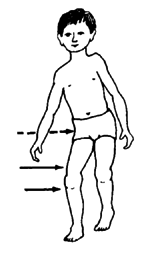
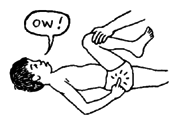
|
The cause in both cases is often unknown but may be related to an injury caused from jumping or failing.
Destruction of the growth center results from a temporary loss of its blood supply, which results in death of the bone.
DIAGNOSIS: If a child has signs of one of these problems, try to get an X-ray to find out the cause.
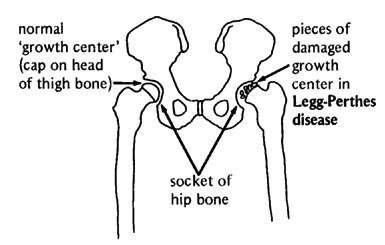
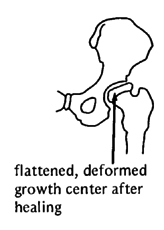
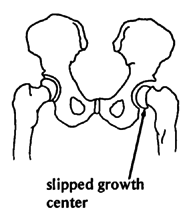
Destruction of the growth center is usually not related to other diseases. In some cases, however, destruction of the growth center from loss of blood supply is caused by tuberculosis of the hip, sickle cell anemia, cretinism, or use of corticosteroid medicines. A careful medical study is advisable.
Treatment and progress of Legg-Perthes disease
When the growth center has lost its blood supply, the bone dies and begins to break into pieces. At the same time, the body begins to make new bone. In 2 to 3 years a new growth center is completely formed, and the child walks more or less normally again, usually without pain. However, the new growth center is usually flatter than before and does not fit into the hip socket as well. As a result, after several more years, the hip joint begins to wear out and a progressive, destructive, painful arthritis may begin.
Many ways to treat Legg-Perthes have been tried. Most methods try to keep the leg in a position that makes the growth center form a round and normal shape again.
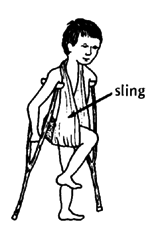
An old method was to prevent weight bearing and keep the hip bent in a sling. THIS DOES NO GOOD. We mention it only because in some countries children are still made to use slings and crutches for years.
A newer method was to cast or brace the legs wide apart.
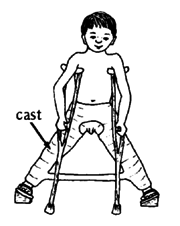
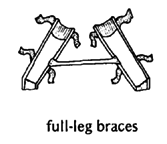
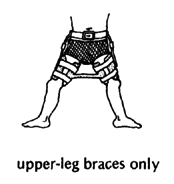
Casts or braces were kept on the child until the new growth center formed completely - usually for 2 to 3 years! This was very hard on both the child and family.
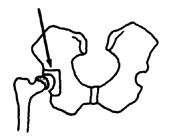
An even newer method was surgery. The surgeon cut loose a piece of bone containing the hip socket,
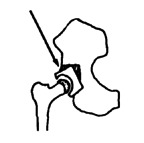
and turned it so the head of the thigh bone fit deeper into the socket. (The result was similar to widely separating the legs.)
Surgery was expensive and had more risks. But it was much quicker: only 6 weeks' bed rest with a cast. Then the child could lead a more or less normal life, without slings or braces. But it still took 2 years for the new growth center to form, and during this time the pain and/or limp continued.
Recent studies show that none of these methods-sling, casts, braces, or surgery makes any real difference. Treated or not, the pain and limp gradually go away-and are 1ikely to come back as arthritis years later. Although many doctors still recommend one or another of these treatments, usually the best advice to parents is to DO NOTHING. (This is a hard decision for parents to accept, but will make life happier for both the child and family.) Let the child remain active, but do not make him run, jump, or walk far if it bothers him. Moderate exercise is important. Swimming is excellent.
Treatment and progress of slipped growth center
When the growth center slips, if possible it should be put back into place surgically, and pinned. When surgery is impossible, the child should avoid all strenuous exercise, running, and jumping in the hope that the growth center will not slip farther until it becomes fused to the thigh bone (normally when the child is 16 to 18 years old). Without surgery, and especially if the slippage is severe, a progressive destructive arthritis is likely to result.
Disabled Village Children
A guide for community health workers,
rehabilitation workers, and families
by David Werner
Published by
The Hesperian Foundation
P.O. Box 11577
Berkeley, CA 94712-2577

